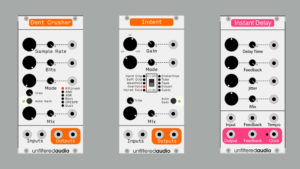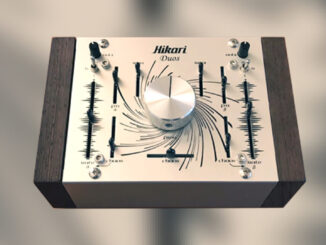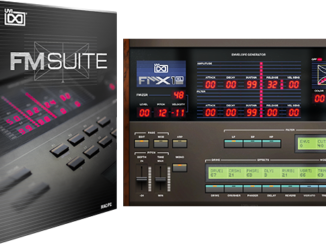In the recent months, Unfiltered Audio has made a name for itself with its slightly different and very interesting effect plugins. Recently, the company discovered another platform, the VCV Rack system. With the new Unfiltered Volume 1, the developers created three new modules based on the algorithms used in their plugins for PC and Mac.
Dent Crusher is a multi-mode bit-crusher , Indent, a multi-mode saturation & distortion and Instant Delay, a granular delay module module. All the modules features several different features as well as full modular architecture.
Unfiltered Volume 1 features:
Dent Crusher
Dent Crusher is a multi-mode bitcrusher based on algorithms that we developed for Dent and Dent 2. It contains six bitcrushing algorithms along with a sample rate reduction section. It also has full stereo operation.
- Sample Rate: Controls the sampling rate of Dent, or how frequently the input is updated. Fully clockwise, Dent will run at the same sampling rate as VCV Rack. Fully counter-clockwise, Dent will run at about 1% of VCV Rack’s sampling rate.
- Bits: Determines the resolution of the active bitcrushing mode. Fully clockwise, no audible artifacts will be present. Fully counter-clockwise, the signal will be as degraded as possible.
- Mode: Selects the active bitcrushing mode (see MODES below).
- Mix: Sets the balance between the dry, unprocessed input and the wet, processed output.
- Trim: Sets the output level of the wet signal.
- Auto Gain: When enabled, Dent will attempt to auto-match the amplitude of the input and output signals using a rapid compression algorithm. Please note that percussive signals with sharp transients can produce amplitude artifacts. This is more noticeable on Indent with extreme gain values, though.
MODES
- Bitcrush: Standard bitcrushing algorithm.
- AND: Turns the signal into a 16-bit integer and uses an AND comparison against another 16-bit integer set by the Bits knob. Extremely aggressive. This mode is recommended for synthesizers.
- XOR: Similar to the AND mode, but uses XOR logic. Try this on a sine wave.
- Bent: Simulates bit destruction in a circuit bent toy. This algorithm was created by Olivier Gillet of Mutable Instruments.
- CRISPR: A milder, micro-bitcrush. Gets deep into your signal and makes it crispy.
- Dust: An unusual masking-based crush that thins out your signal.
Indent
Indent is a multi-mode saturation and distortion module. It contains ten different algorithms and has full stereo operation.
- Gain: Controls how much amplification is applied to the incoming signal before it is sent through the saturation algorithm.
- Mode: Selects the active saturation or distortion mode (see MODES below). We’ve put in a sophisticated algorithm to smoothly change the active mode, so modulating this can produce excellent results. You will want to use a slower modulation signal to hear the individual modes more clearly.
- Mix: Sets the balance between the dry, unprocessed input and the wet, processed output.
- Trim: Sets the output level of the wet signal.
- Auto Gain: When enabled, Indent will attempt to auto-match the amplitude of the input and output signals using a rapid compression algorithm. Please note that percussive signals with sharp transients can produce amplitude artifacts, especially when using extreme Gain values.
- Range: Sets the expected voltage range of the incoming signal. Most oscillators in VCV Rack are within the +/- 5V range. Some oscillators, however, may exceed this range. One example is the Audible Instruments Resonator.
MODES
- Hard Clip: If the signal’s amplitude exceeds the limit set by the Range switch, it is simply clipped to that boundary. This is an aggressive, digital-sounding form of distortion.
- Soft Clip: The signal is saturated using a parabolic equation. This will actually affect the sound of the entire signal in a subtle way. This clipping is more pleasant and analogsounding.
- Wavefold: Signals that exceed the threshold are “folded” around the threshold. There is more sophisticated shaping at play here, but essentially this can change the perceived frequency of the sound. A great way to hear this is to use a simple sine wave as an input, then increase the gain on the input and outputs.
- Overfold: A combination of wavefolding and overdrive. Try this mode out on bass frequency sawtooth waves!
- Harsh Fold: A much more brutal, digital-sounding implementation of wavefolding.
- Distortion: A more traditional distortion algorithm. Excellent for guitars.
- Tube: A partially rectified saturator that greatly attenuates negative components of signals.
- Tape: A modified soft clipper with a parabolic equation that more closely matches the saturation behavior of tape.
- Gloubi: “Gloubi-boulga” waveshaper.
- Cubic: The signal is multiplied by itself three times.
Instant Delay
Instant Delay is a modulation-friendly delay based on the “Modern Instant” mode from our award-winning Sandman Pro. It is a granular delay that does not suffer from clicking or pitch-shifting artifacts when the Delay Time parameter is changed.
- Delay Time: Controls the length of the delay buffer. This controls goes from about 1 ms to 10 seconds. If a clock (trigger or gate) is present at the Tempo jack, this will act as a clock divider/multiplier. The signal at the Clock output is a gate that is equal in length to the delay buffer.
- Feedback: Sets the amplitude of the wet output signal that is sent back to the algorithm’s input. Essentially, this controls how many “echoes” you will hear. For more fun, Instant Delay has a Feedback Input and Feedback Output. This will allow you to add additional processing to the feedback line. As an example, try taking the Feedback Output and sending that to a filter. Run the filter’s output back into the Feedback Input. Now, you can filter each echo. Nothing is stopping you from sending the feedback loop through another instance of Instant Delay…
- Jitter: Randomizes the length of the delay buffer with each cycle. Fully counter-clockwise, no randomization will occur. Fully clockwise, the length of each delay buffer cycle will be randomly chosen between 1ms and the time set by the Delay Time knob.
- Mix: Sets the balance between the dry, unprocessed input and the wet, processed output.
The Unfiltered Audio Unfiltered Volume 1 is now available for $29 USD on the official VCV Rack store.
More information here: Unfiltered Volume 1





Be the first to comment